Wild Horse, Nevada
I’m sitting in Howie, parked right on the shore of a lake in northern Nevada. We have the place to ourselves, and I’m thinking Dang, we just can’t make a bad choice on this trip! To get here, Howie had to slither through a bit of mud, and dodge 239 beet trucks, but it was well worth it.
Early that morning, we were ready to leave City of Rocks (well, not really ready, but we had to start heading home), and we did some map-shopping for our usual priorities: off the beaten path, wide open spaces, water, canyons, vistas, etc. A tiny little corner of Nevada looked interesting enough to give it a try. It was back over in the lonesome Owyhee area, and there was paved access via a new-to-us highway, ID-51/NV-225.
After only a quarter-inch of rain the night before, the dirt roads leading out of City of Rocks were already starting to take on the slimy nature for which we have so much respect. In one short stretch, all 15,000 pounds of Howie started acting like a hockey puck on wet ice, sliding sideways with zero directional control. Fortunately, we rolled/skidded out of it before drifting off the road. Look at the photo – – it doesn’t have to look ugly to have near-zero traction. It was yet another lesson for us, of how incredibly treacherous these roads can be when mixed with a little water.
But we reached the pavement unscathed, and put the pedal down. We had almost 300 miles to put on the day, so we chose a least-favorite path, an Interstate highway (I-84). Unfairly, we boogied past some of the best of Idaho in this process, leaving Twin Falls, Shoshone Falls, and the Fossil Beds, untouched. And that is to say nothing of skipping past miles and miles of Snake River territory – – we kept making mental notes to ourselves to come back and get to know these places better.
At first, I-84 was pretty miserable. For a lot of reasons, I will typically keep Howie at about 60mph – – but the big trucks like to do 70+. So it was just constant whuff-whuff-whuff as the monsters rolled on past me. We tried a brief stint on ID-30, but it turned into a quagmire of 25mph zones and stop lights. So back we went to I-84, and dancing with semis. We watched a LOT of hay and beets go by, I must say. But they eventually thinned out, and after not TOO long a time, we finally made our turnoff onto ID-78, and a few miles later headed southbound on ID-51. What a relief.
ID-51 is smooth, empty, peaceful, and in places scenic. Even when it’s not scenic, it’s clean and uncluttered. We’ll take a back road like this over an Interstate almost any day. At the Nevada border, ID-51 becomes NV-225, and three miles later is the town of Owyhee, in the middle of the Duck Valley Indian Reservation. We topped off our water there in the middle of a bog made by their (leaky) faucet.
After Owhyee, NV-225 starts into the mountains and follows the east fork of the Owyhee River. Another thirty miles took us down through the pretty winding river canyon to Wild Horse Reservoir. There’s a nice little riverside camp (Wild Horse Crossing) a few miles north of the reservoir, with great, simple camp sites right on the banks of the river. But it was canyon-walled, and we passed it up, being in the mood for a grander view.
At the north end of the reservoir, the Wild Horse dam is one of the smaller we’ve seen, looking for all the world like it was made from cinder blocks.
Down below the dam, a guy was bird-hunting along the river with his dog. (We heard him take three quick shots in succession, the legal load for a hunting shotgun. I don’t want to be snooty, but rapid fire is usually a sign of a poor marksman. If he shows me a couple of birds, I’ll take back my words.)
Just a little further upstream (south), the land spread out and the Wild Horse reservoir appeared. Unlike many of the bodies of water we’ve seen these last two years, it was nearly full, maybe only 20 feet down.
Camping opportunities here are literally all over the map. The northeastern shore has about 10 entrances (we didn’t count them all), one to a BLM camp, one to the State Park, and the rest to “tribal campgrounds”. At first, we thought the ‘tribals’ would be restricted to Indian use – – but on the contrary, they’re public-use campgrounds with very modest fees. Sites run $6-7 a night or $30/week, and range from level paved strips to pretty much dispersed-style fire-ring “locations”. The BLM camp is no-frills, $5 a night, and the State Park is wide-spaced gravel pads with adjacent shade covers and $14. Nobody anywhere has hookups except the RV park(s), which we didn’t recon. All told, there must be at least 200 sites available, and that doesn’t account for lots of dispersed sites with just a fire ring. It must get pretty jammed up here some times of year.
Along the tribal-camp shoreline, we really liked a couple of by-the-water dispersed sites, and we even parked in one, right on the shore with a sweeping view of the lake. But the ground was pretty soft, and Howie dug in a little bit. With more rain in the forecast, we opted for the 100% safety and peace of mind of a paved camp, slightly higher up. Our first evening saw us to sleep accompanied by the gentle lapping of wavelets on the shore.
Our first day promised to be the best, weather-wise, and we drove into the State Park to see if there was a Ranger there. Sure enough, a friendly, knowledgeable guy gave us a lot of good information about the area, including a couple of suggestions for ‘road tours’. When we mentioned we were staying in a tribal camp, a curious thing happened – – a kind of shadow passed across his face, and I asked him what he thought of the area. He was reminded of the crowded season (mid-summer), when the tribal camps and shorelines were so lined with people that nobody could fit in edge-wise. He also mentioned that the “rowdy level” peaked at the same time, often requiring legal intervention. The Nevada State Park Rangers are armed and trained, and they/he occasionally need to put it to use. We ended up feeling very thankful about being there off-season, and vowed to stay in the (supervised/policed) Park if we ever wandered by in summertime.
The BRUNEAU-JARBRIDGE Loop Tour
After our chat with the Ranger, we blasted off on what would be a 120-mile dirt-road tour through the back country. This route looks a bit ominous on the maps, because it is criss-crossed with other dirt roads every few miles – – potentially pretty easy to get lost, as we have discovered on many past explorations. But with the guidelines from the Ranger, four map sources and five different GPS units on-board Ralph, we figured we could work it out.
Executive Summary: Fabulous trek, totally worth the time and trouble. Extremely varied terrain and flora, wild empty lands, grand views. And not a really difficult road – – mostly.
The Route: Gold Creek Road (745), cross the Bruneau River and turn east on 751. Follow 751 over to 752 and then south to Jarbridge. (This path bumps up into Idaho for a few miles.) Then continue on 752 out of Jarbridge, climb past Bear Creek and Coon Creek summits, and continue on 748 all the way to Charleston. At Charleston, turn west on 746, follow that all the way to NV-225; then turn north and back to Wild Horse. [The road numbers are from the latest USFS map. Other maps may have different numbers.]
The ROAD to JARBRIDGE
The first section of Gold Creek Road is smooth and fast, belying some of the slower and rougher areas to come. We’d find this to be a common factor in our drives around the area; the mountain sections were far more difficult, and less maintained, than the flatter areas. But even before the road got rougher, we were already being rewarded – – the road follows a lava-buttress canyon with striking formations at literally every turn.
Like many formations in the west, some of the weathering was absolutely artistic, not to mention flirting with gravity.
Crossing the Bruneau River, we found it nearly hidden by the golden Fall foliage surrounding it. What a beautiful complement it was to the fields of golden grass covering the hillsides.
Everywhere we traveled, we’d come across hunters’ camps, some of them in the most picturesque settings.
We reached the northeast edge of the Humboldt Forest, and looked across the hilltops at the mountains of Idaho. We would visit them for only a couple of miles before turning back into Nevada and heading south to Jarbridge.
But before we could get to Jarbridge, we were to follow the (you guessed it) Jarbridge River. Like so many of the waterways in this region, the river courses through craggy canyons topped with intricate lava spires. Once again, a postcard at every turn.
At Jarbridge itself, we found a scattered community of buildings both plain and quaint. All the structures are loosely spread along the river, making it essentially a one-street town.
Visitors were as eclectic as the town itself. Check out the little one in the middle (below), with the Snoopy glasses. They were driving the same big loop as us, only they were doing the whole thing in an open-air quad. We felt humble, and wimpy – – – and comfortable. <grin>
Near the southern edge of town, we stumbled on, of all things, a set of working gas pumps. Quite a sight out in the boonies, to be sure. We talked to the owner, who had just recently put in a self-pay pedestal. He said it was “wicked expensive”, but worth it because he wasn’t tied to the station, and could come and go as he pleased. Although the price/gallon was silly high (150% of normal), we cheerfully topped off Ralph’s tank. Being in the back country is a lot like aviation – – the only time you have too much gas is if you are on fire.
SIGHTSEEING SURPRISES
Before I continue this trip narrative, I’d like to tell you about a little slice of our traveling. Just a personal anecdote really, perhaps some background for future notes, as it were.
We are always looking around, seeing what there is to see. Every now and then, Karin will spot something that I (usually) don’t see. No surprise – – she’s sharp-eyed, and I’m watching the road a lot of the time. However, when the thing she sees is remarkable or exciting, occasionally Karin will enter her “Stop Stop Stop” mode. At least, that’s what I’ve come to call it. It goes kind of like this:
- >> unusual road-side event or appearance takes place << (could be an animal, scenic, another vehicle, whatever)
- Karin: “STOP! STOP! STOP! STOP! (repeat 12-16 times) LOOK! LOOK! LOOK! LOOK! (repeat 6-9 times) OVER THERE! OVER THERE! OVER THERE! (repeat 4-8 times). [All repetition counts are approximate. Sometimes expressions are interleaved, “STOP! OVER THERE! LOOK!“, etc.]
- Greg: <screeeeech> (brakes locked up, sounds of gravel flying and hitting fender wells) Looking hard, independently out of both eyeballs simultaneously, chameleon-like – – I have learned now to never ask “where?”, because that prolongs the OVER THERE portion of the episode. I simply look in the direction that Karin is excitedly gesturing. Often, I even see what she sees. When I see it, I say “yes, got it”, which will occasionally truncate her exclamations, but not always.
This sequence tends to occur on almost every exploration we make, and even at times just cruising down the road in Howie. It’s always a lot of fun for us both.
RETURN from JARBRIDGE
After some coffee and ice cream and gasoline, we left town toward what was reputedly a pretty steep grade. Ralph was not afraid; his True-Trak rear differential has amazing capabilities in loose terrain – – but I did lock up the front hubs.
Well okay, it wasn’t straight up, but I estimate the grades probably hit 15-20% in a couple of spots. The biggest issue was that it was very loose rock and gravel, and extremely easy to spin tires, so the 4WD was not so much mandatory as just far more comfortable. There was just not enough traction otherwise, and we would have been throwing gravel all the way into Idaho.
The big surprise going through this section of the forest (Copper Mountains) was the forestation at the higher elevations. Going up through Bear Creek and Coon Creek summits carried us into a dense conifer forest, totally different from the sage/grass/pinyon/juniper of the lower elevations. It was akin to being transported to the high Sierra or Rockies.
But desert is desert, Mother Nature can’t be fooled, and moisture is hard to come by in these parts. The forests were widely scattered, and interrupted by expanses of low grass and scrub. The effect was like being in a new world, unlike any of the others we’ve seen.
Just a few more miles westward and a thousand feet lower, and the forests became only a distant glimpse. This lonely campsite looked out over beautifully rocky, low-growth terrain almost as far as could be seen.
Even further west, the slopes flattened and the ranch activities again dominated the landscape. Stretches of private land, meadows, fences, and cattle dotted the valleys as we worked our way back toward the paved highway. Keeping the pastures moist (for ranching) also turns some lowlands into wetlands, and the waterfowl were totally happy about that.
A few miles before coming back to NV-225, we passed a batch of aspen in the gathering dusk. I saw a large dark fluttering out of the corner of my eye, and Karin executed the STOP! LOOK! OVER THERE! syndrome. I looked, and this time I found it right away.
Shyly perching back amongst the dry branches, a great horned owl was waking up for his night’s hunt. When he got far enough away from us to feel safe, he paused long enough for me to swap lenses.
While we watched him, he was kind enough to demonstrate that amazing head-swivel thing that owls do, about 270 degrees of motion (3/4 of a full circle). It’s so cool to watch them do that. Looks like something out of a horror movie.
Full left, over his left shoulder – – – – – – and almost full right, over his right shoulder.
What a wonderful way to end the tour and the day. We headed back to Howie for a peaceful evening.
The JACK CREEK – MAGGIE SUMMIT Loop Tour
The Ranger also told us about a shorter, easier tour on the western side of the area. We tried this out on the last day before the weather descended on us.
Executive Summary: Excellent way to spend a half-day cruising through the mountains. Not a lot of spectacular scenery, but enough to be a worthwhile tour. About 60 miles of half-dirt half-pavement, crossing westward over the mountains and then back east again. One section of fairly narrow, rough road going west, and the rest reasonably smooth and fast dirt roads or highways.
The Route: South on NV-225 to Jack Creek Road, then west. (Continue south for optional side trip to the Jerrett Mine, then return north.) Take Jack Creek (732) along the north fork of the Humboldt River, across the Independence Mountains to NV-226. Turn north, and follow NV-226 to the end of the pavement, then turn onto Maggie Summit Road (729). Follow 729 over the summit and down to NV-225. This intersection is about halfway between Owyhee and Wild Horse, 11-12 miles each way; a great place to make a side trip for gas, which is not available in Wild Horse. Turn south on NV-225 to return to Wild Horse. [The road numbers are from the latest USFS map. Other maps may have different numbers.]
The JERRETT MINE
A few miles south of Jack Creek Road, a solid paved road runs in about five miles to the Jerrett Mine. The Ranger told us that this gold-mining operation pulls about a half-million dollars a day out of the ground. Substantial. We decided to make a side trip and see what we could see. At the turn-off, we followed a UPS truck into the area. (Is there anywhere these guys don’t go?)
[UNEXPECTED GIFT!!! – – on the way in toward the mine, our cell phones beeped that they had a signal, and we were able to pick up 3-4 bars of 4G. We checked our emails, deleted the spam, made a couple of calls, and kept on going. Nice to get caught up now and then.]
Far across the valley, the mine’s footprint was visible. Structures, roads, power lines, tailings, all made their mark on the desert landscape. It’s well worth remembering how intrusive these operations are on the “natural” scheme of things, and I’m firmly convinced that mine operators must legally (and morally) commit to a reasonable level of restitution of the area that they ravage. The old days, of crapping all over the landscape and walking away, need to be put behind us forever.
All that said, there’s some kind of fundamental fascination to mining. Whether it’s a tiny shaft in a hillside dug by a lonely prospector, or a giant open-pit operation scoured out by an international conglomerate, we always seem drawn to the diggings.
I wish I had more to say and show about this mine, but we were unable to arrange a visit/tour. The gate guard was pleasant enough, and indicated that visits were occasionally supported. But the day we were there, they were locked down for a safety inspection, preparatory to a “shot” (blasting operation) that afternoon. No visitors, no personnel available, no luck. (Mining operations have been historically so dangerous, that now they are drenched in safety regulations and precautions.) The guard gave me a number to call to arrange a tour, which we absolutely will do on our next visit – – (775)-738-5006. I haven’t tried it yet, so I hope it’s useful. If not, when we have Internet, I’ll dig up some way to get in contact.
NV-225 to NV-226 via JACK CREEK SUMMIT
This road started off wide, smooth, and fast with just a bit of washboard ripple. It continued that way long enough to get us lazy and complacent.
Then, the road started playing with us. A few rocks, some flooded potholes, and some free-range cattle. Take your pick, just don’t get bounced off the road or stuck, and DON’T plant a cow on the hood.
Muddy bottom or rocky bottom? Sometimes you just have to try it out. (this one was rocky)
But it wasn’t really challenging, as back-roads go, just a bit slow. And the summit (as with most summits) was worth it.
Descending west, the road widened and smoothed again, but still found some pleasant scenery to wind its way through.
Just before NV-226, ranchland once again reigned.
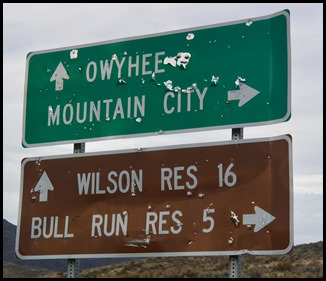 NV-226 goes only a few miles north before it runs out of asphalt.
NV-226 goes only a few miles north before it runs out of asphalt.
At that point, Owyhee can be reached by either north-bound or east-bound routes, even though the sign says different. We took the right-hand arrow.
NV-226 to NV-225 via MAGGIE SUMMIT
This time, the smooth road lasted pretty much the entire passage. This is a grand dirt road, albeit with a fair share of washboard. And some of the washboard would rattle Ralph nearly off the road. But only that – – no real rocks, no potholes or swampy spots. We cruised.
Again negotiating a pass through the mountains, some pleasant scenery passed us by. Not Nat-Geo cover scenery certainly, but still some pretty spots that made us glad we came.
It was late October when we went through, and most of the color had disappeared from the foliage. The aspens were stripped bare – – –
– – – and only the willows and some creek-bottom stuff had any yellow or orange left to it. Over and over again, we kept saying “Wow, we really need to come out here in the Springtime.” We think it will be spectacular. Locals say that the wildflower bloom occurs late (July), and that would be a special time too.
As the road neared NV-225, the usual ranch lands appeared – – this time with some UN-usual residents. Aside from a quick giggle, my main reaction to this display was “OK, I guess ranching can’t be that demanding, ’cause someone sure had a lot of time on his hands.”
Hitting NV-225, we were at the half-way point between Owyhee and Wild Horse, and Ralph was down to 1/2 tank. But we figured we’d not be doing much exploring in the upcoming bad weather, so we headed south back to camp.
We scared off a whole batch of ravens from a not-too-fresh cow carcass along the side of the road – – but this magpie wasn’t having any problems staying with the feast.
So we followed the Owyhee River and trundled on back to camp.
By our last day (Friday), the forecast weather had come true, and really settled in on us. Nearly 24 hours of almost non-stop rain and overcast would put a big dent in Howie’s batteries, and my photography.
Morning brought only a wet gray sky and wind-streaked water at the edge of our camp.
We spent a relaxed and thoroughly unexciting day; drove down to the mine road for Internet, got a burger at the (only) diner, watched some dogs and a rancher take hay to some cattle. Not a lot to make up a story about….
I’m not exactly sure how the dogs were helping, but they sure seemed content about their roles in the whole affair.
Huntin’ country is where you find deer-antler TP holders.
A little rain doesn’t keep the fishermen inside. These five guys popped out of the SUV and threw lines in the water, sun or rain don’t matter when you’re fishin’.
So, like I said, a super-kicked-back day.
At that point, we were only a few days from home, via an awful lot of I-80. There might not be a whole bunch to write about, and this could be my last post for a little while.
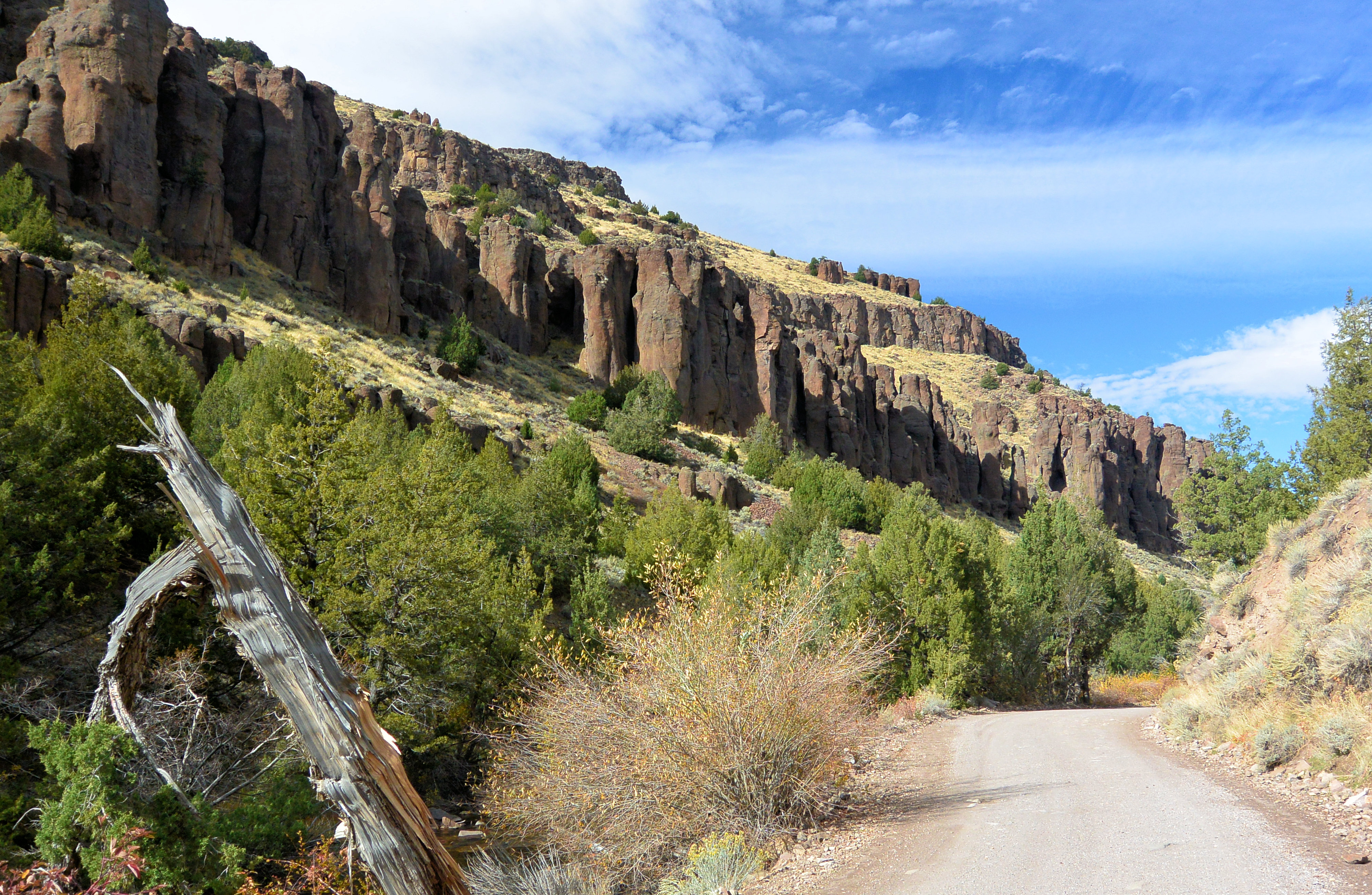
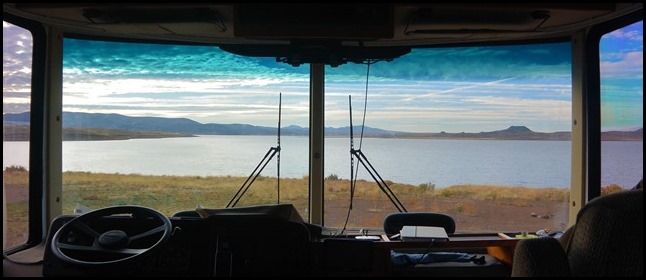
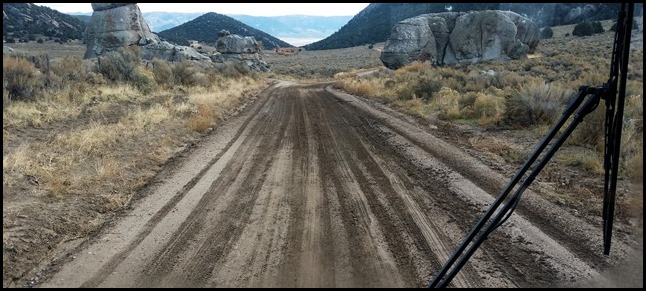
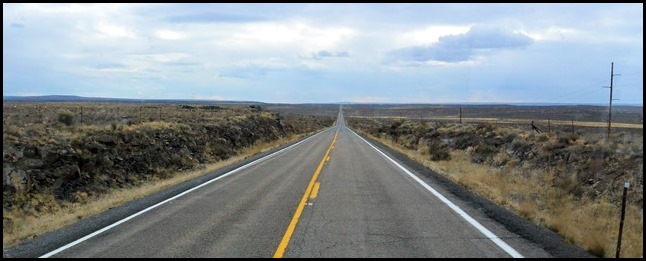
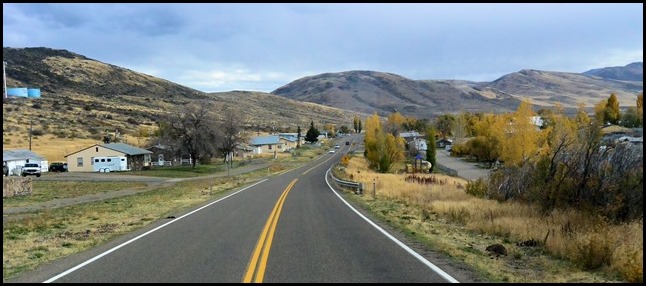
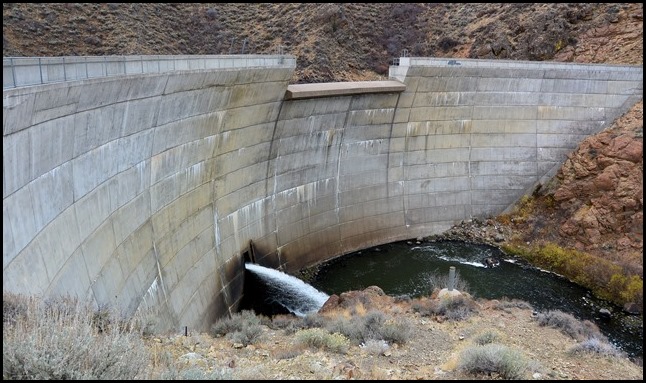
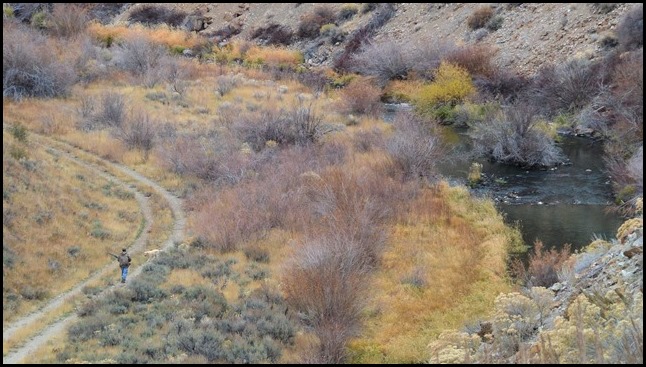
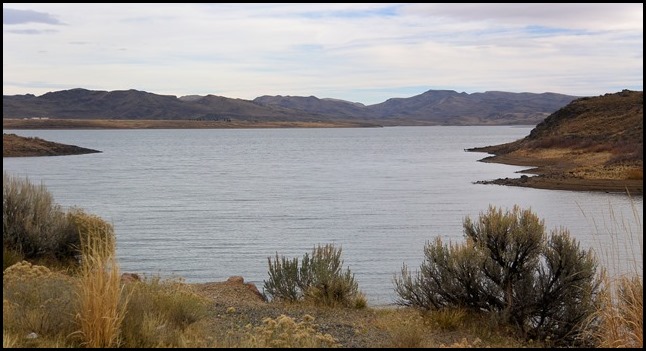
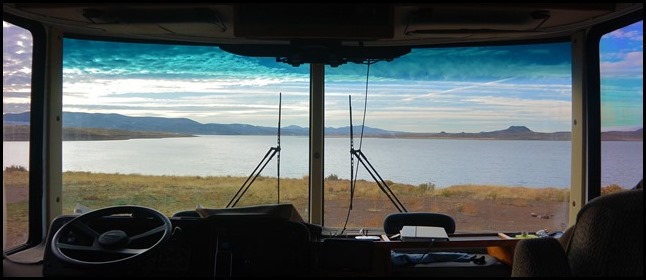
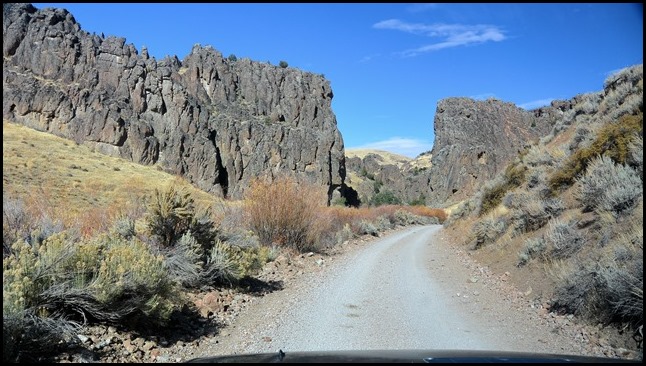
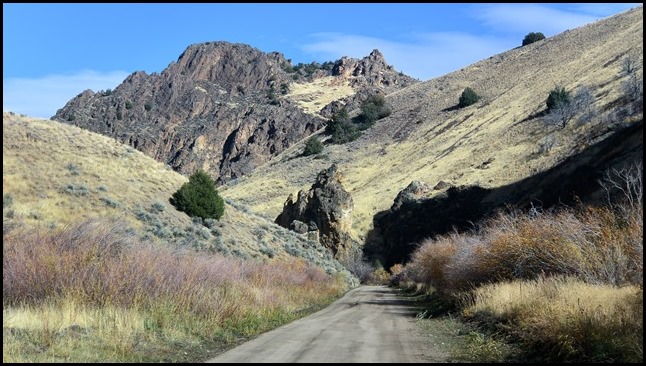
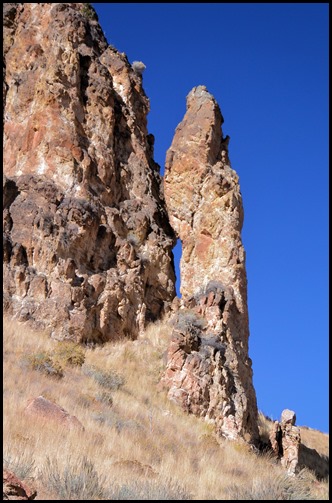
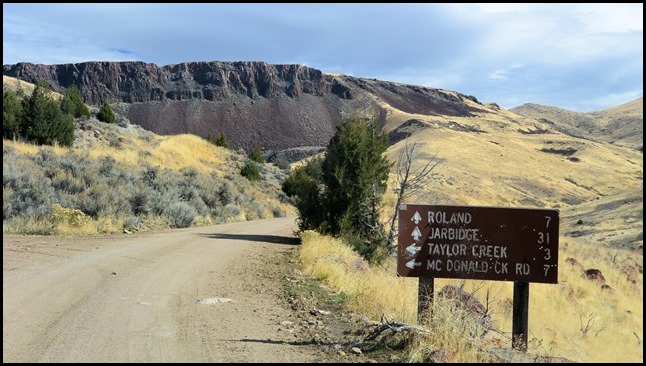
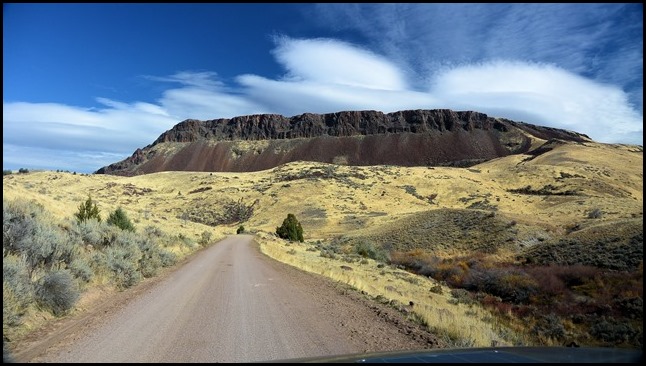
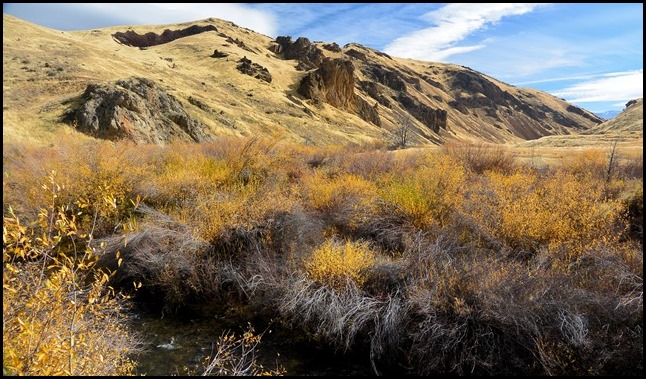
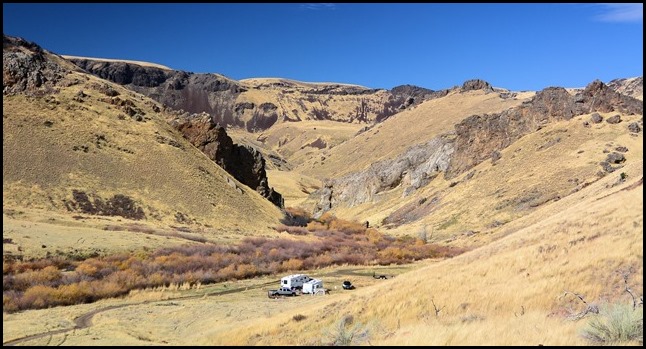
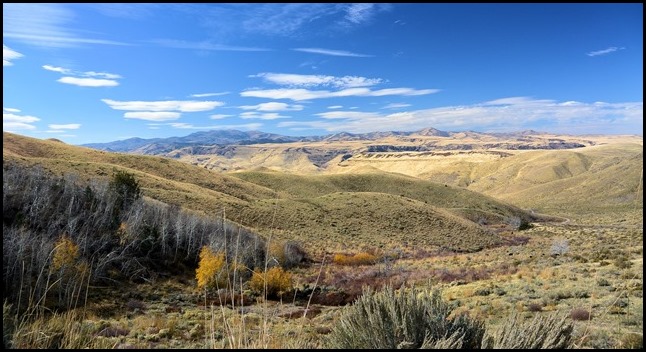
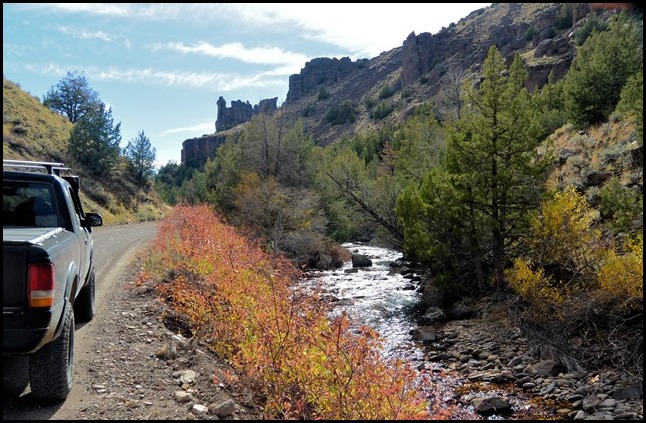
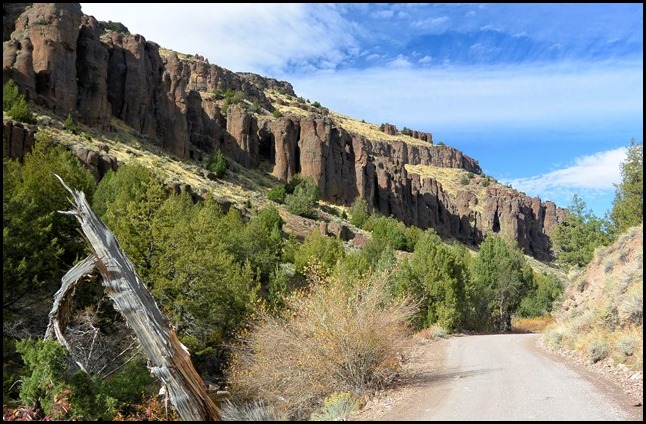
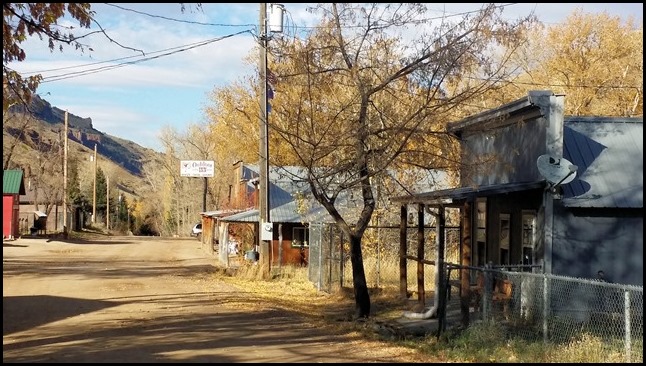
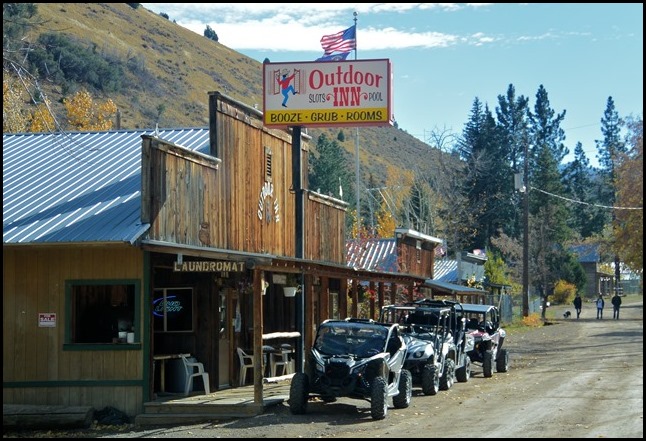
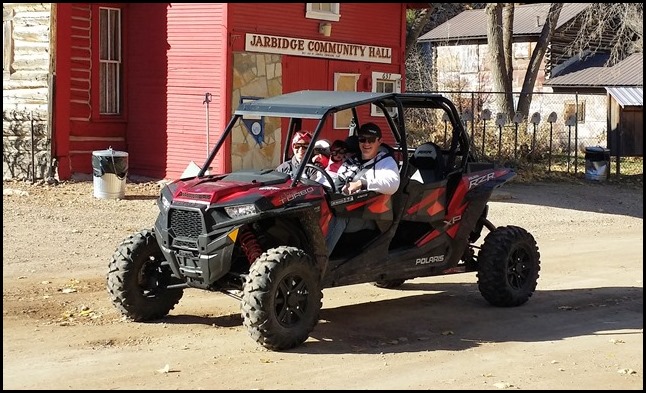
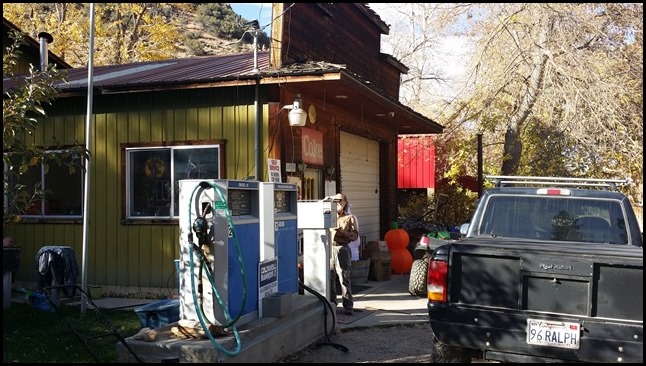
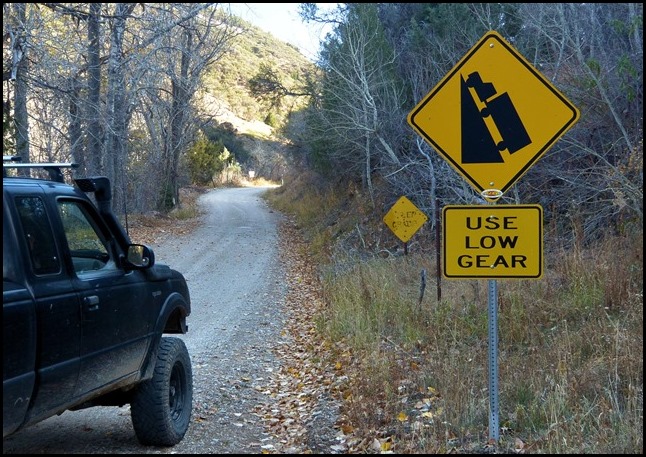
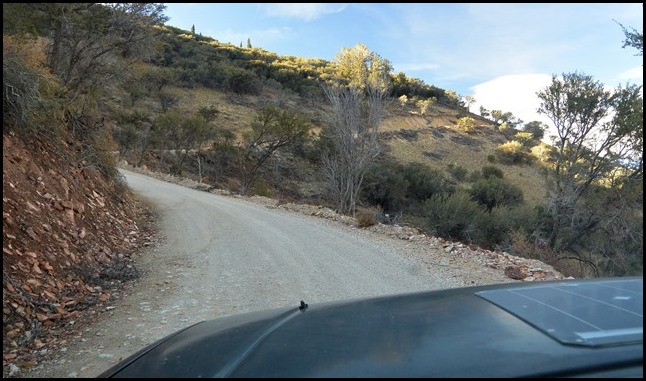
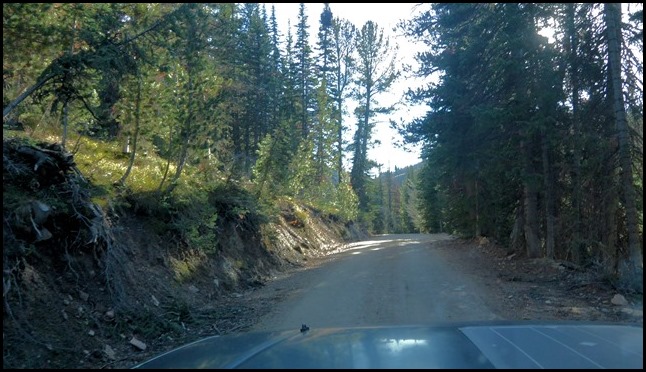
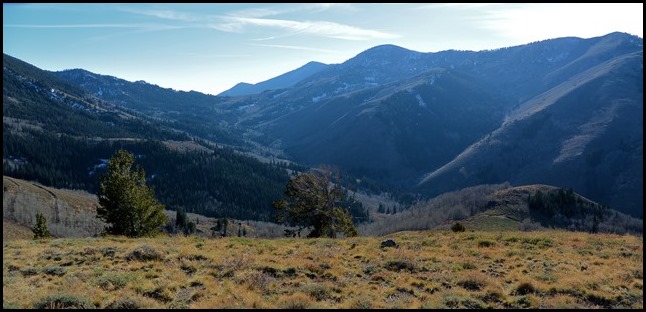
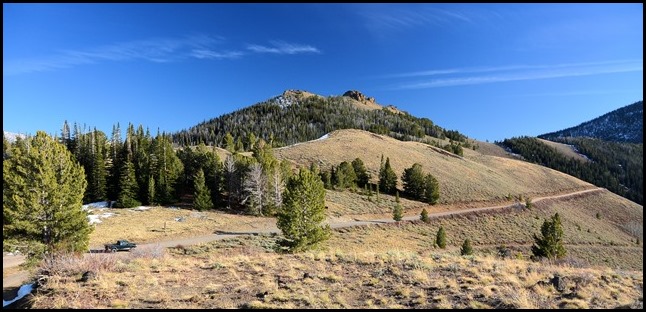
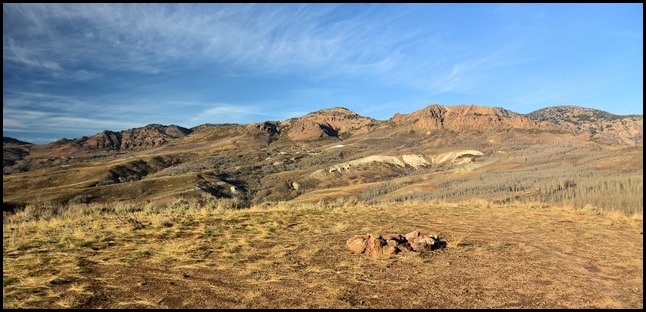
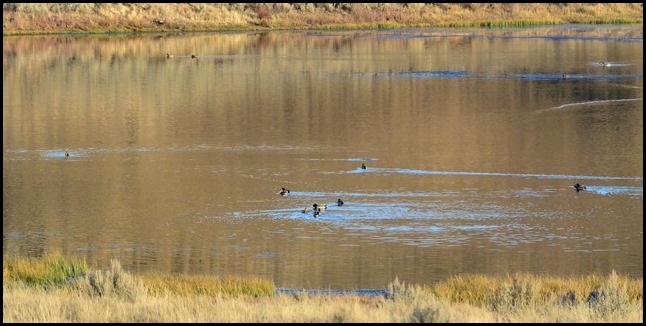
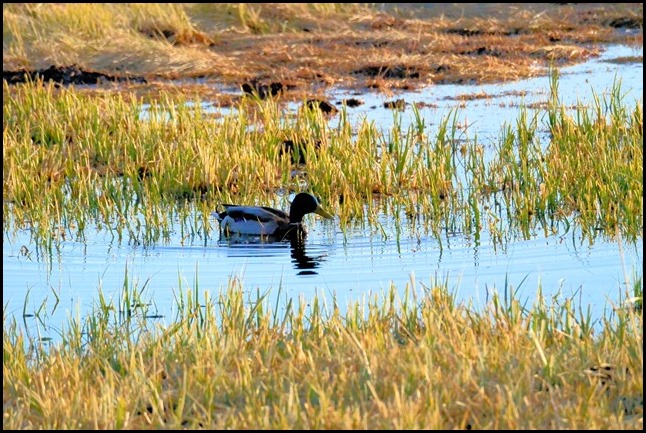
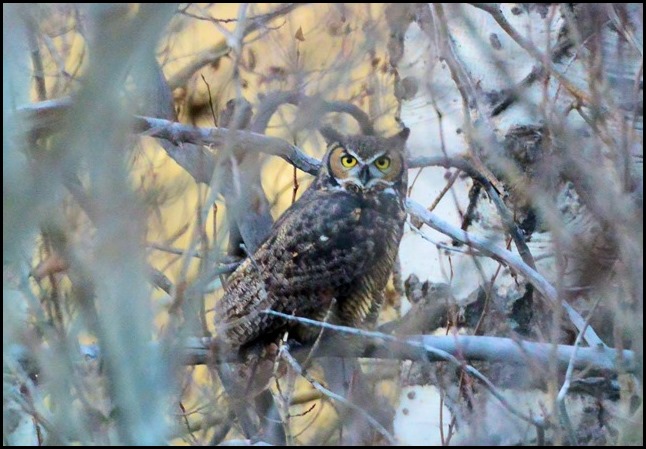
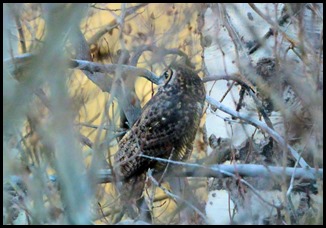
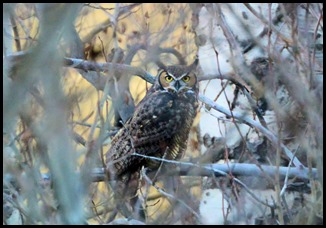


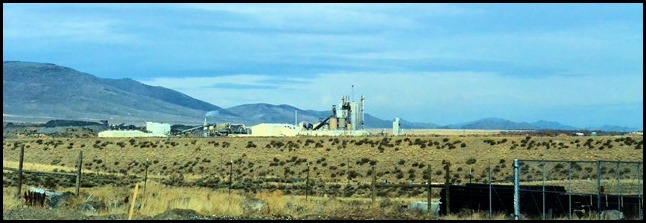
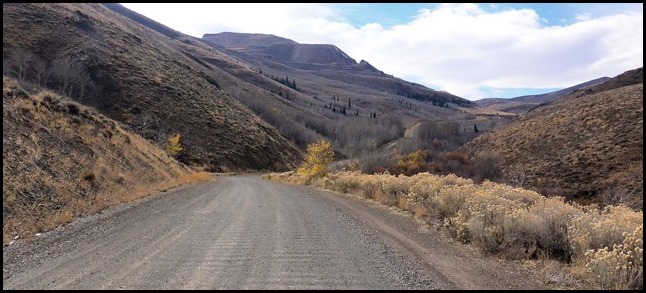
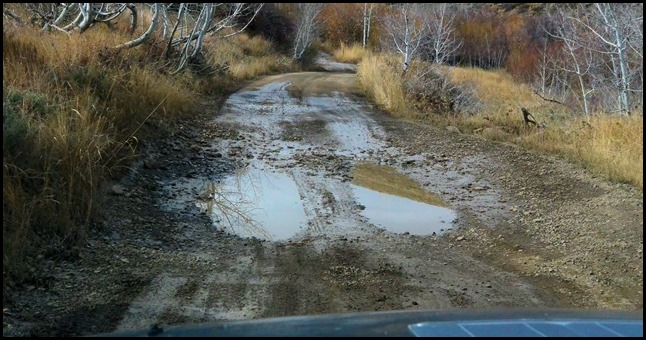
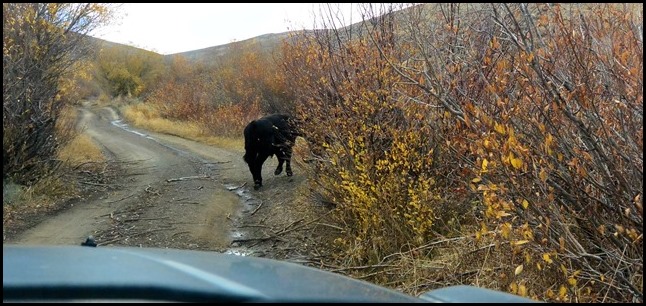
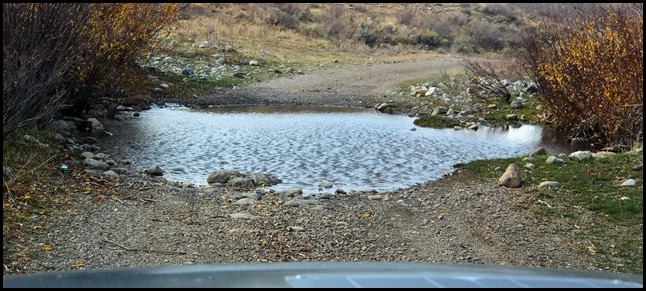
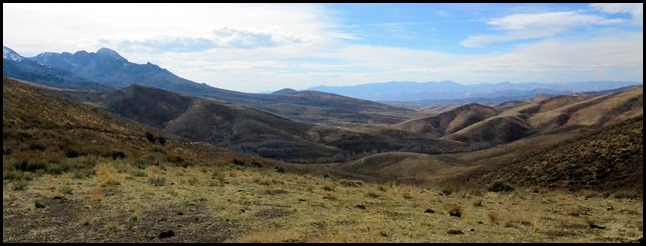
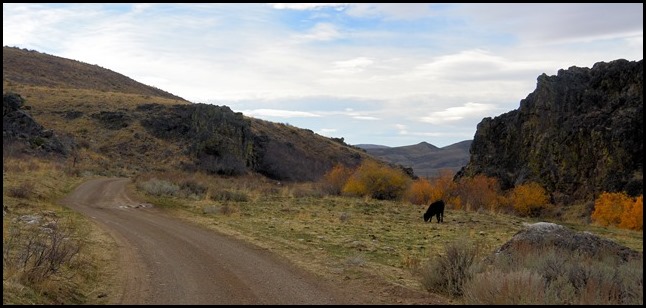
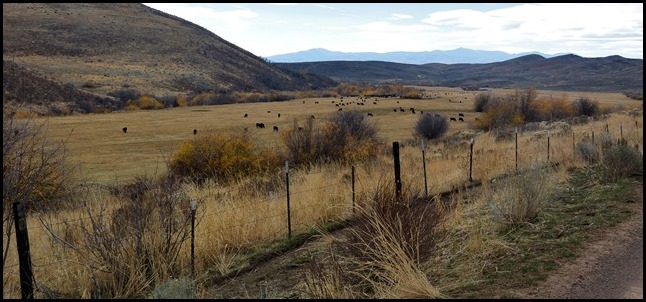
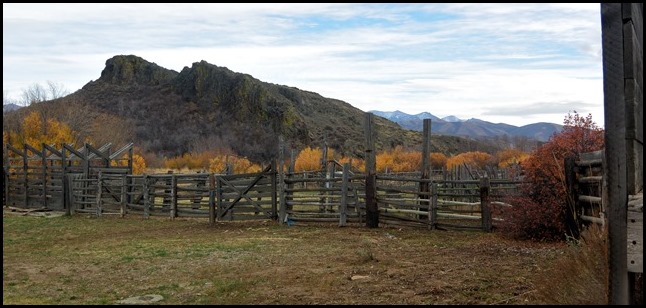
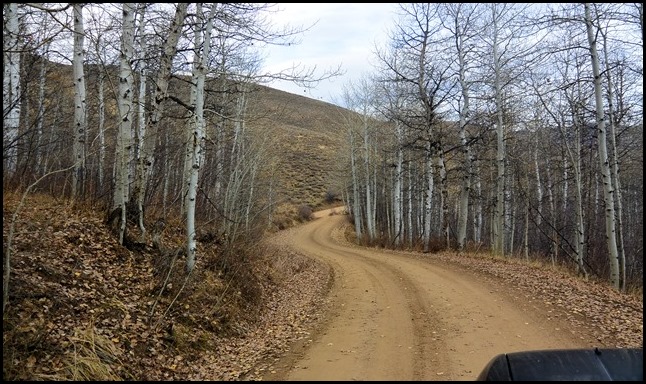
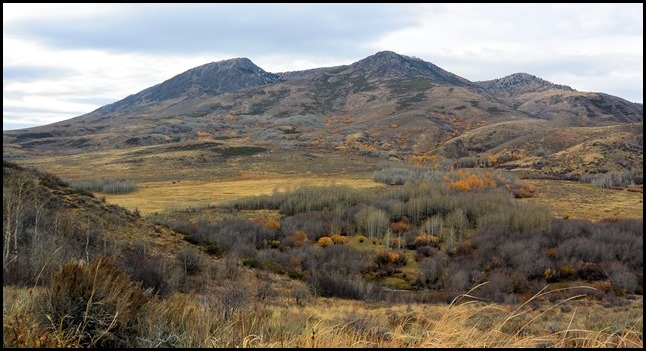
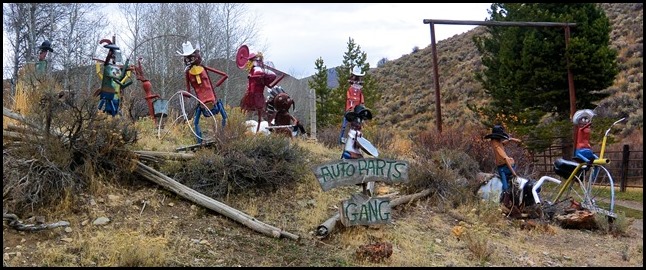
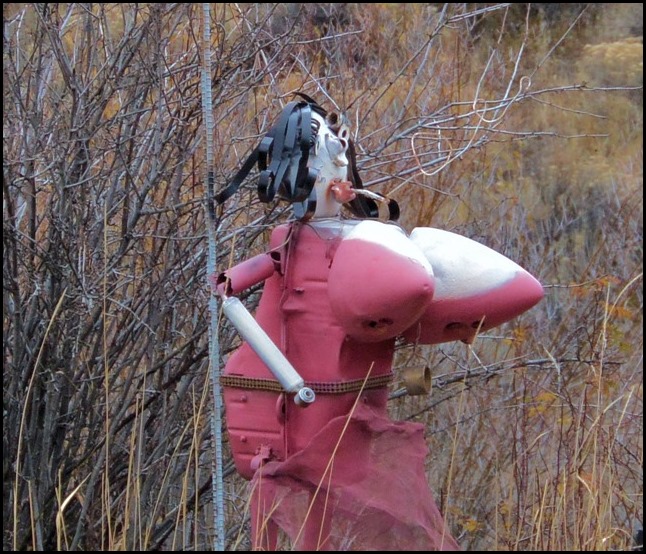
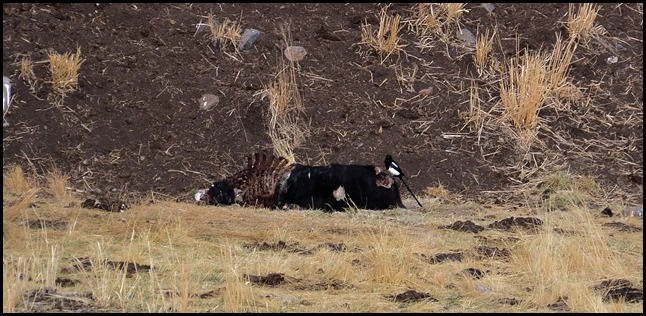
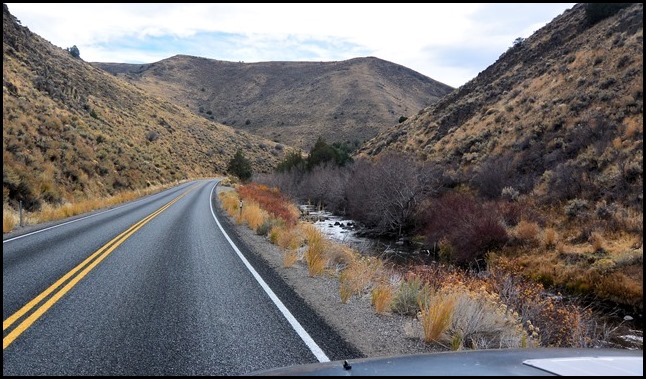
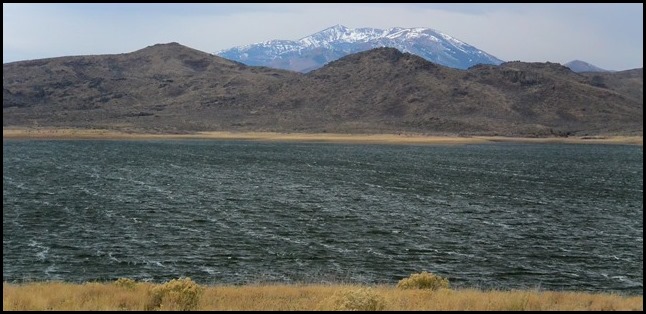
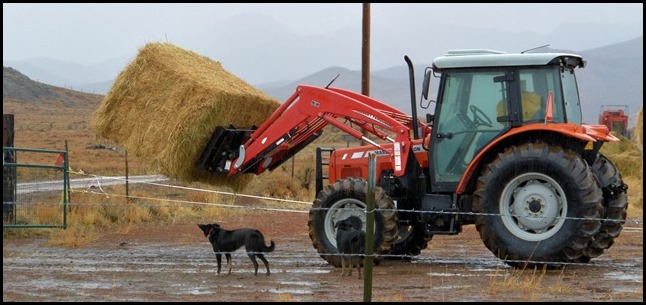
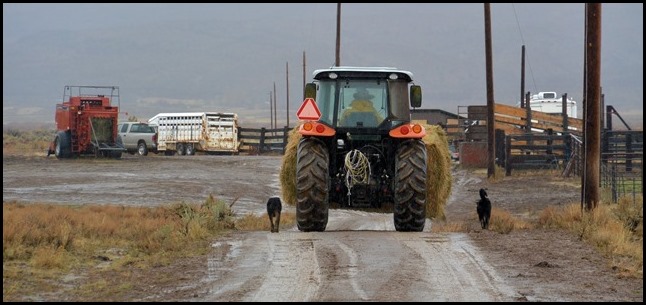
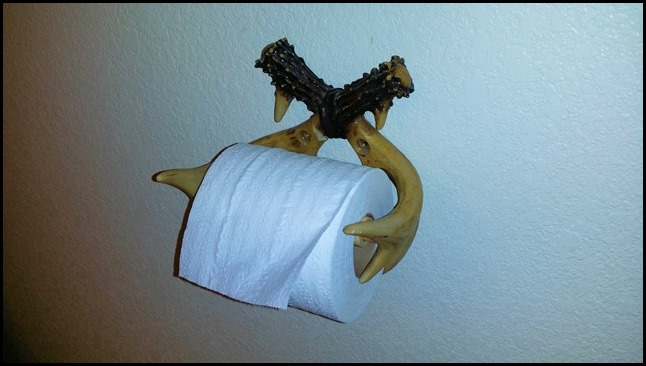
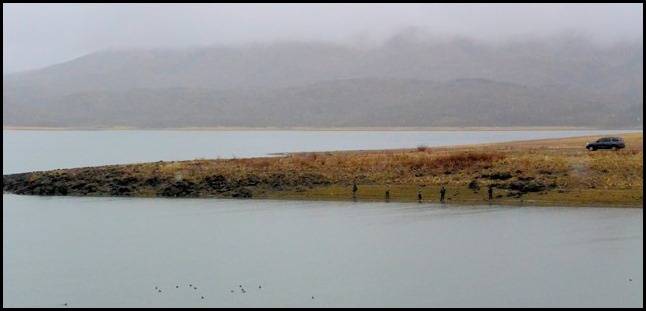
HI GREG AND KARIN,
ENJOYING YOUR POST
WONDERFUL PICTURES.
ARE YOU STILL USEING YOUR NIKON, MIRRORLESS ?
BAILEY SENDS HER HELLO.
WE ARE ON OUR WAY TO HOLE IN THE WALL, THURS.
MERRILL AND BARBARA
Hey Barbara and Merrill,
Thanks for keeping up with us. Yes, I’m still using the Nikon V2, and I love it and am getting quite used to it – – – but I bought a 70-300 lens for it ($$$$$), which is a 190-810mm equivalent. That’s the lens I used to shoot the horned owl. It’s a fabulous lens, very fast to focus, plus it has an auxiliary manual-focus ring for fine-tuning. Lots of fun.
We’ll be headed home in a day or two, and then out to family in Vegas for Xmas – – not headed for Hole in the Wall until (maybe) January or February.
Have a grand time, great to hear from you….
G.
Not much to say other than I am enjoying your posts.
Ever tried ham radio? I think it might go well with your back country exploring.
Art
N1ITK
Art,
I’ve thought about ham radio occasionally. I’ve also considered CB, since there are likely to be lots of local subscribers. CB is of course a junkyard, with very limited range. Ham is much better, but I’m not sure what I’d be able to accomplish (support-wise) with a contact hundreds or thousands of miles away. It also has range limitations, especially in canyons and deep valleys.
My solution for now is the InReach, a satellite communicator that lets me text/email from anywhere in the world. I use it for (minimal) communication with family and friends, and more importantly as an SOS backup for that hope-it-doesn’t-happen emergency.